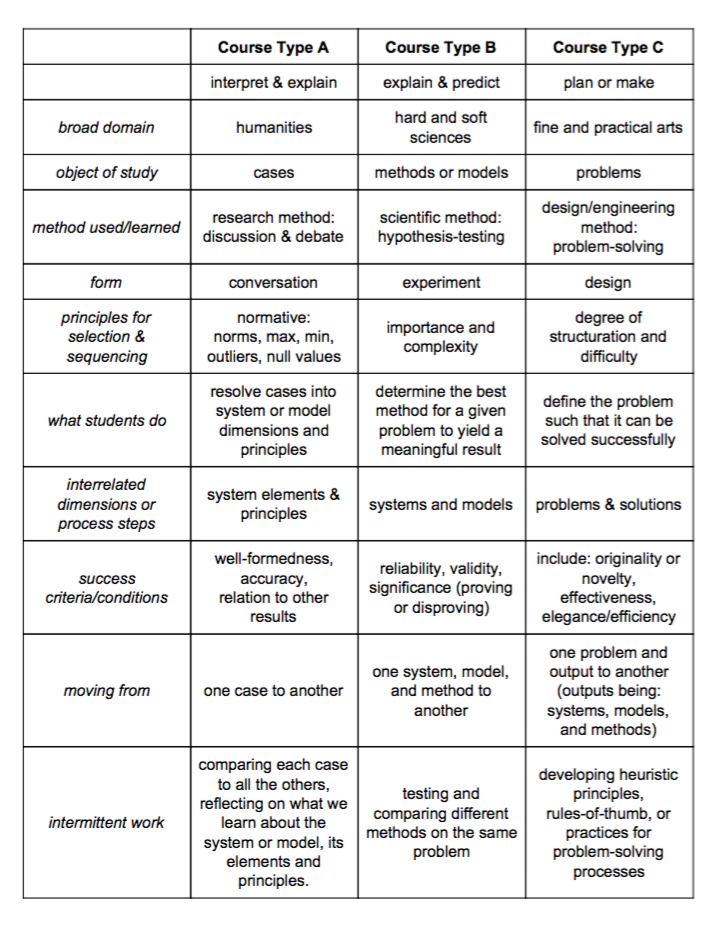Podcast #53
In this episode we go conceptual and talk about a new way Edward has devised to categorize courses into three distinct types. The first, Interpret-and-Explain is common in the humanities, business schools, and some advanced courses in the social sciences. The second, Explain-and-Predict is the predominant type in the sciences where theories, models, and methods are central. The third type, Plan-and-Create is the primary mode of many arts and engineering courses. We look back at our past episodes for good examples of each, and discuss when and why you might want to teach using a method that’s atypical for your discipline. At the end we go meta and try to fit our podcast into this ontology and ruminate on our goals for the podcast.
You can subscribe to the Teach Better Podcast through your favorite podcast app or simply subscribe through iTunes if you don’t have one yet.
Show Notes
0:00 ⏯ Intro
0:39 ⏯ Stepping back, thinking big. To transfer or redesign a course, it helps to know what a “course” is–It’s not just a stack of slides or lecture notes.
4:55 ⏯ Talking to an economist, you can ask what the “model” for the course is. The design for a thing is not the thing: you can’t drive the design for a car.
7:05 ⏯ Thinking about courses like a software engineer: the specifications, the implementation, and the design. The software layer model: the data layer, the interface layer, and the business rules between the two.
10:44 ⏯ First Course Type: interpreting and analyzing a series of cases within a single system: many films, one Hollywood system; many poems, the English language. You can’t always spell out how the system works. Bottom-up vs. top-down.
14:44 ⏯ Second Course Type: explaining and predicting, comparing methods, hypothesis-testing. Doug’s econometrics course is theory-driven but uses motivating examples. But an econ course about a single substantive topic (like the healthcare system) can use the interpret-and-analyze approach.
21:15 ⏯ The case study model interprets and analyzes. The course types can be blended, and more advanced courses tend to blend the types.
22:50 ⏯ Third Course Type: Planning, making, or creating; and it’s common in the fine and practical arts (including design and engineering). Teaching screenwriting. Avoiding fake plan-make-create. Students don’t know when they start making something what will and won’t work.
28:46 ⏯ The course types also correspond to a naturalistic sequence of: analyzing past cases, testing hypotheses, and planning and making something new.
30:12 ⏯ Olav Sorenson uses a Socratic approach to get students to interpret and explain a series of business cases. Donald Kagan dramatizes historical events. We usually contrast lectures and seminars, but we’re doing something different. The course types bring students into the core disciplinary methods: interpreting, predicting, designing.
34:45 ⏯ Geoff Connors role-plays or simulates the cases: students still need to interpret and explain; they also make predictions; but it’s interactive, not a lecture. Content layer vs. interaction layer: yes there are a series of paintings, but what does someone do with that?
38:41 ⏯ Unusual approaches to interpreting & explaining: David Berg on organizational psychology. Frank Robinson uses film clips in a physics class as cases that students need to interpret.
43:24 ⏯ Doernberg and DiPietro teaching neurobiology in a prison. David Easley teaches about networks with clickers and other interactive elements. It’s hard to teach history as a predictive art. Larry Sameulson teaches intermediate microeconomic theory as a series of models. Slowly removing presuppositions. The challenge of teaching abstractions and methods.
52:28 ⏯ Walker White has his students plan, make, and create: computer games. Teaching design often starts with simple but highly-structured problems, then moves to complex unstructured problems. Students and teachers can also make explicit heuristics and rules-of-thumb that makers use. Print is declining and video is rising.
1:00:12 ⏯ The types can also be blended. Lynn Regan’s graduate course on proteins asks students to role-play. Matt Jacobson’s students create an historical exhibition: interpret-and-explain becomes plan-make-create.
1:07:58 ⏯ Doug’s dry intermediate micro-economics course: asking students to create models of markets they care about.
1:10:56 ⏯ Seeing enough examples to recognizing patterns.
1:12:55 ⏯ Which ‘type’ is this podcast? Interpreting and explaining cases of good teaching. Sometimes rules-of-thumb emerge, too.
1:19:04 ⏯ The podcast as edutainment. Signing off.
Our handy wall chart of course types:
